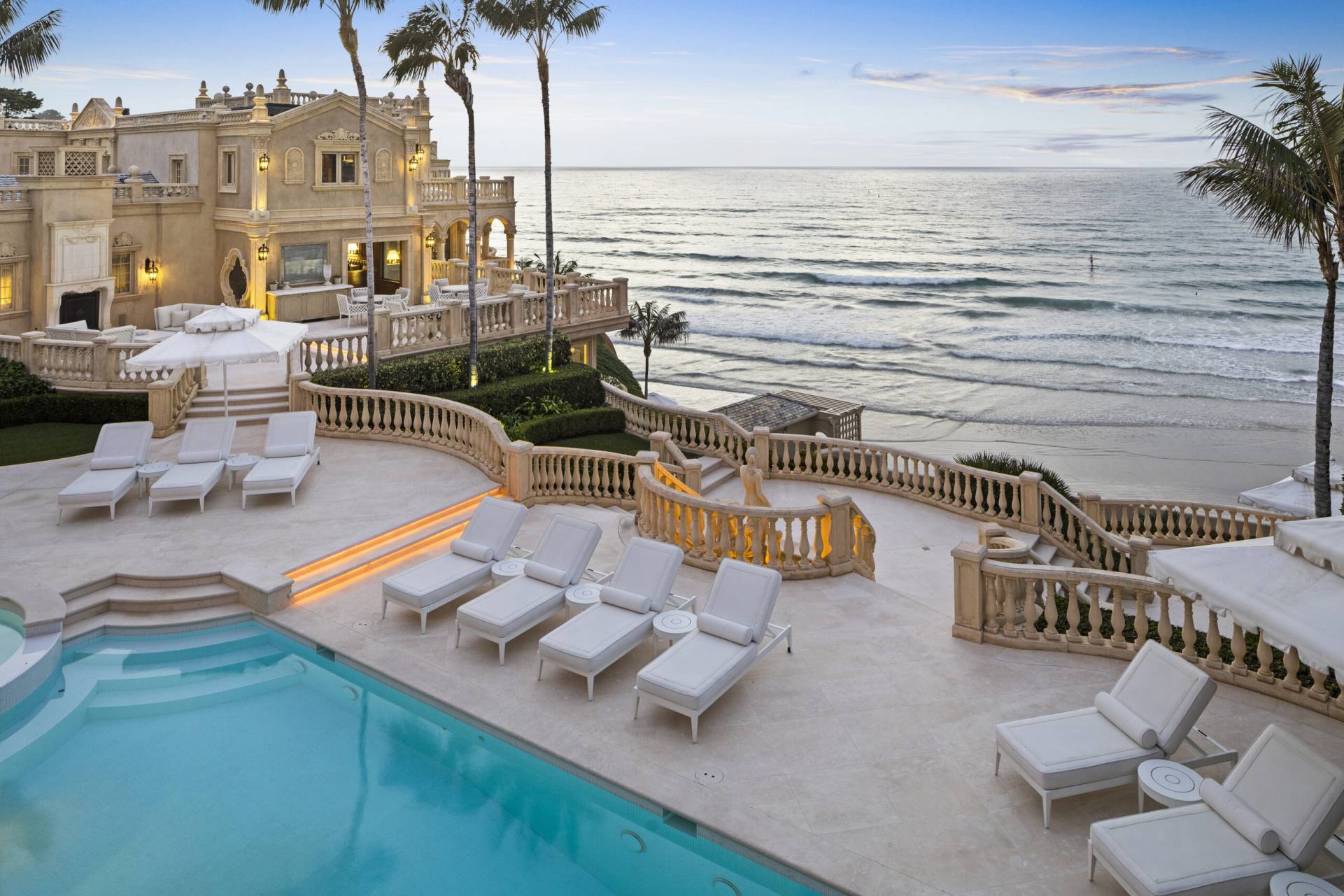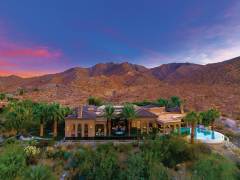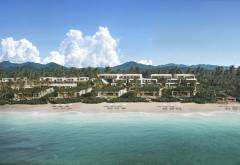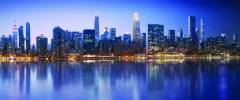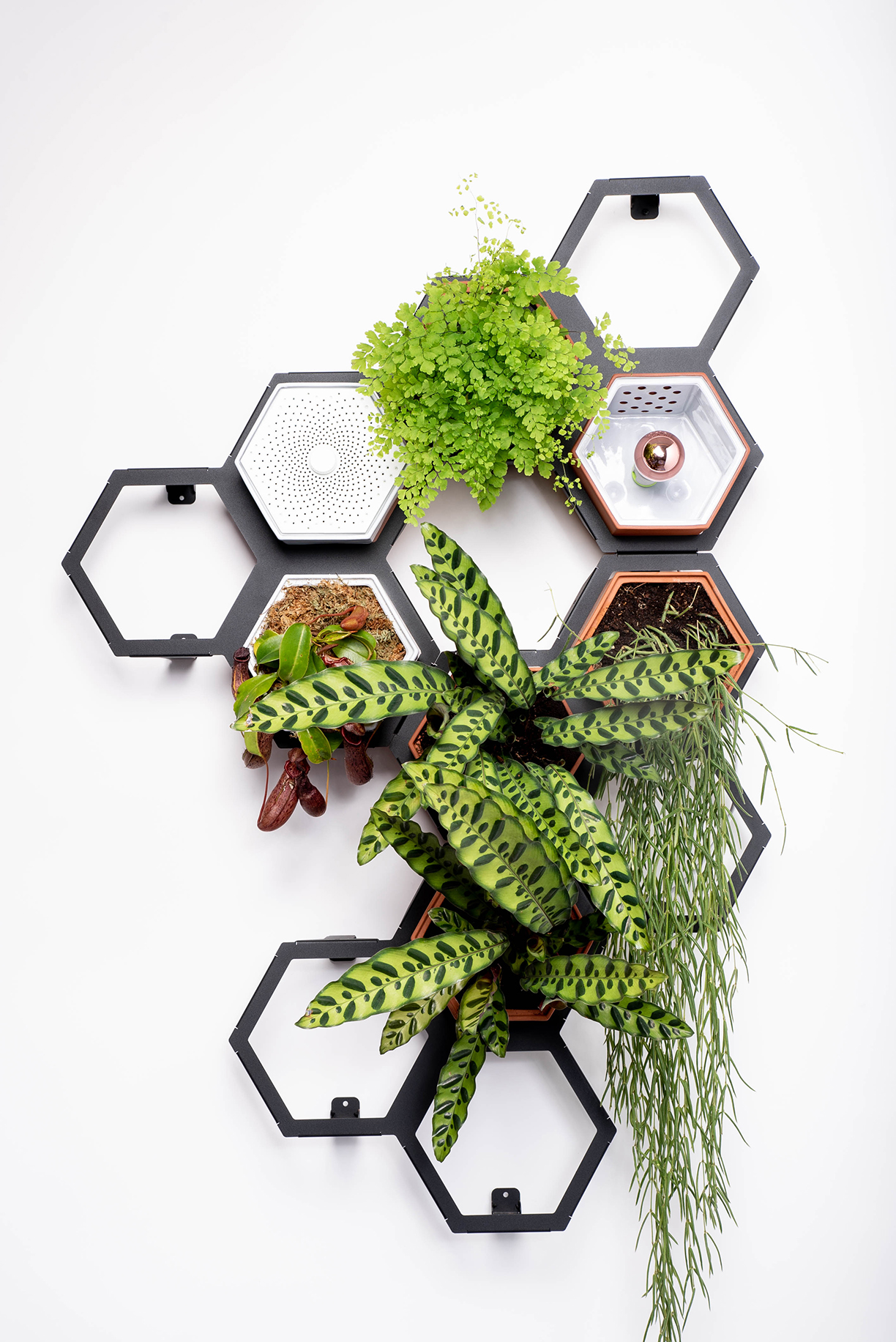
All photos courtesy Horticus Living.
Having a large collection of plants is amazing, but it can get a little crowded with our floor space disappearing pretty quickly. This is particularly true for city dwellers.
43 percent of Londoners live in a flat, the most of any region in the UK, promoting the move of our gardening skills to our balconies and our living rooms. With the mean average UK one-bedroom home being 46 square meters ( or 495 square feet), according to Riba, space is one of the issues these horticulturalists face.
By focusing on a desire to nurture carefully grown fauna, UK company Horticus Living has rethought the living wall, made it more flexible, and kept the practice of cultivation while keeping a minimalistic lifestyle.
Horticus is a modular living wall system that can grow in keeping with your botanical demands. You choose the size and layout according to your preference and it doesn’t have to be all plants either. Use an empty planter for mementoes or select from pods with different functions.
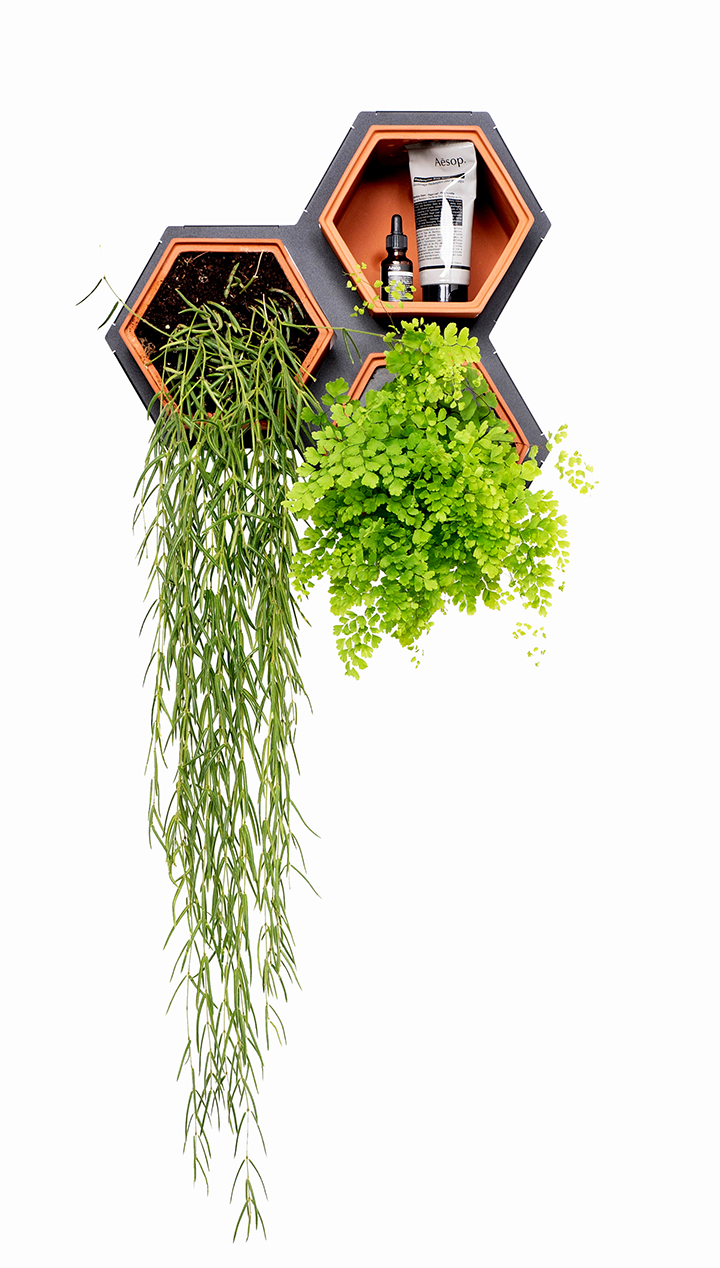
You can grow your living wall at your own pace. There is no need to get a lot of plants straight away to have the impact.
Horticus Living’s small kit consists of 1 powder coated steel frame and 3 terracotta planters and can add a touch of jungle to a bathroom, bring fresh herbs to a kitchen and a sense of calm to a living room. Planters are made from terracotta and can be lifted in and out of the frame. Even better, the planters can be watered from above through a grid of watering holes.
The combination of powder coated frame with terracotta brings a natural feel to interiors while offering a fantastic contrast to the greenery.

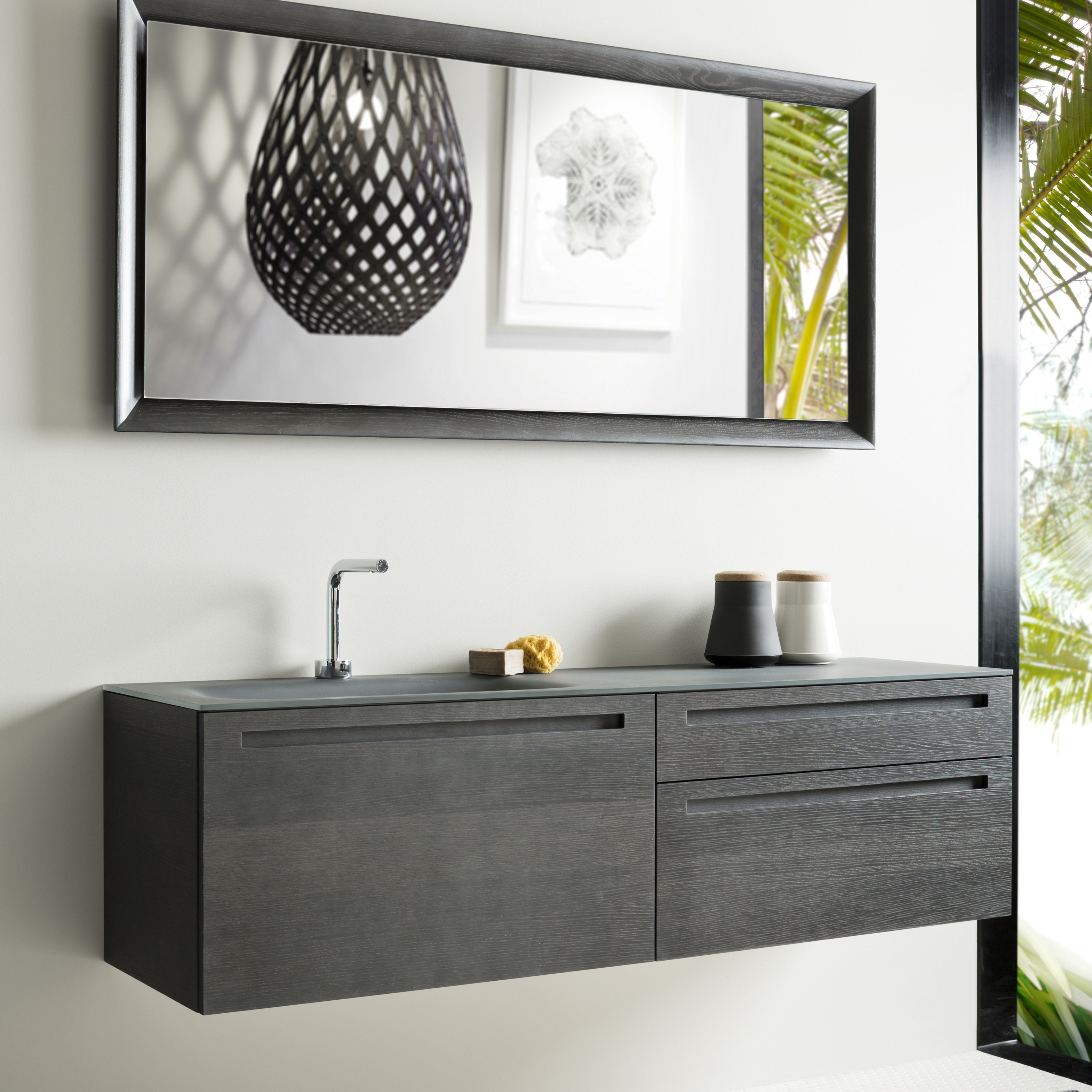
Falper Vetro Integrated Cabinet Glass Top Basin. All photos courtesy Rogerseller.
‘Green’ design and products have historically found their classification in the product features themselves and not necessarily in the processes behind the production, or the facilities that produce them.
But that’s beginning to change, with more emphasis given to the green cogs that keep the green machine going.
Luckily, you don’t have to go green with envy at what others are doing; below, we’ve listed several firms working to contribute to the green movement.
Claybrook
Utilizing recycled marble that is a by-product of its mosaic tile workshop, Claybrook’s MarbleForm bathware is manufactured in a low impact, emission-free production process, using environmentally sustainable products, materials and manufacturing methods wherever possible.
With a unique wet polishing method, which incorporates water, the method is healthier, cleaner and safer, the result is a finer and smoother texture for a superior finish.
Apart from the fact that these pieces are made from recycled by-products, the actual products themselves can be recycled too.
At right: Claybrook Skye Bath
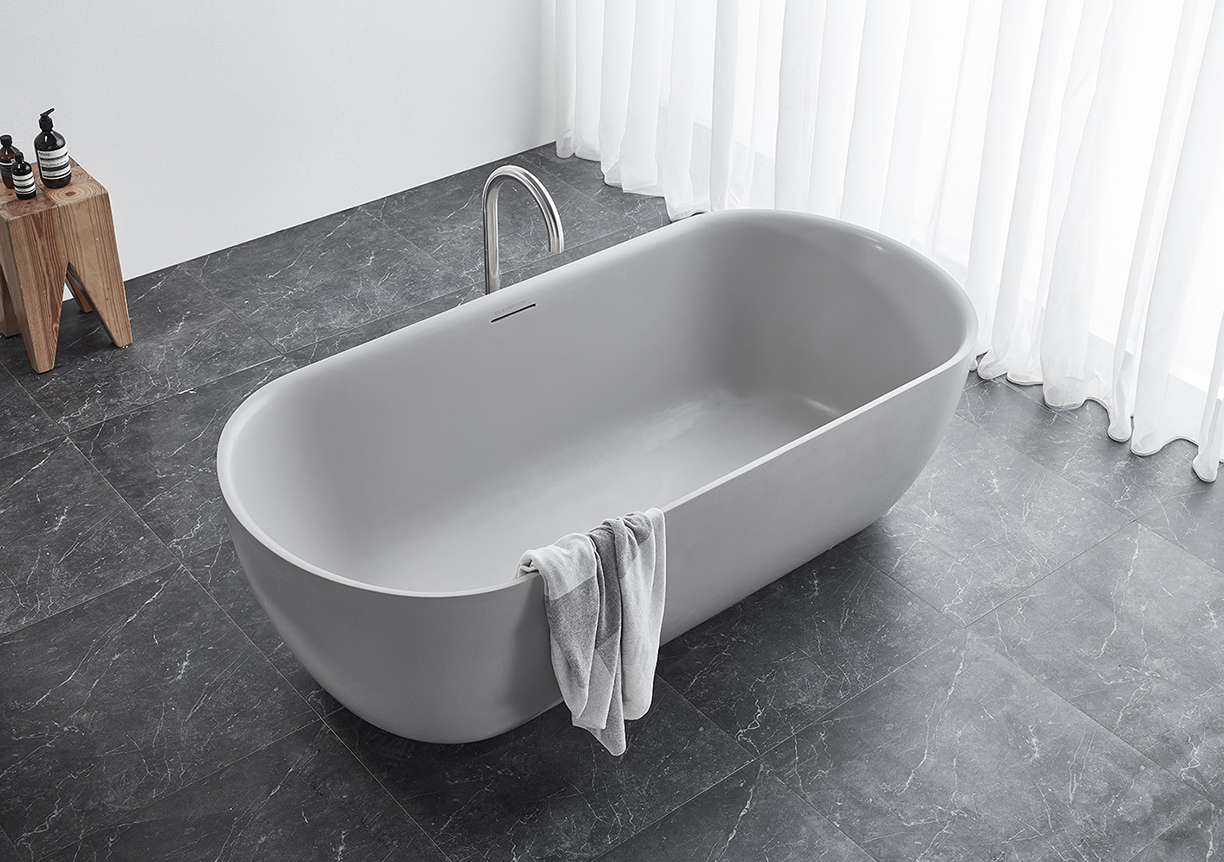
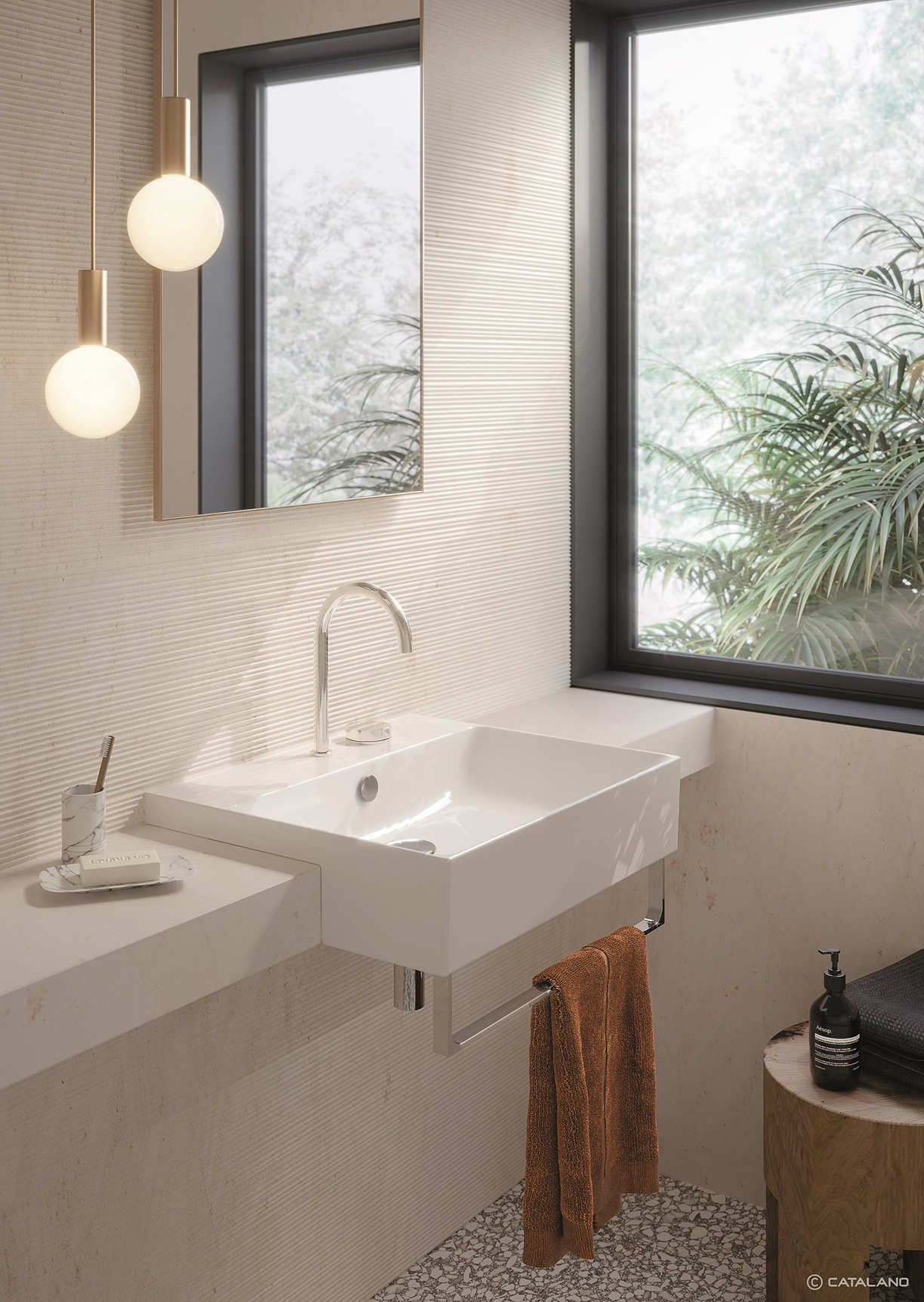
Catalano
“Think Green” is the motto of Catalano, who has been pursuing sustainability and respect for the environment at all stages of its production cycle for years. The firm prides itself in using pure raw materials without any risk of toxicity, while cutting-edge technology has resulted in a new generation of products with reduced thicknesses that require less material.
Catalano pays great attention to environmental efficiency and operating conditions of machinery as well; the installation of solar panels at the production plant generates 1,625,000 KWh – about a quarter of its total energy requirements.
Catalano’s plant is characterized by a low-noise impact and features a closed-loop wastewater recycling system, while the production processes facilitate the maximum reduction of volatile fumes and pollutants released into the atmosphere. But its green efforts don’t stop there.
When it comes to its products, Catalano is constantly innovating to ensure it stays at the forefront of technology and its impact on product design. For example, the company’s revolutionary glazing method, Cataglaze+, actively kills bacteria through Silver Titanium technology, eliminates the stagnation of water and reduces the amount of cleaning detergents and water required. The visibly superior aesthetic also guarantees anti-yellowing over time.
At left: Catalano Zero 55 Basin
Falper
Utilizing only natural materials, Falper recycles all of its manufacturing waste.
Each timber panel is certified ecological and all the wood finishes are entirely water-based.
Scratches and breaks are easily restored on the surfaces of bathtubs and washbasins, reducing the need to replace items, while they are also completely recyclable.
At right: Falper Quattro Zero Caldera bath
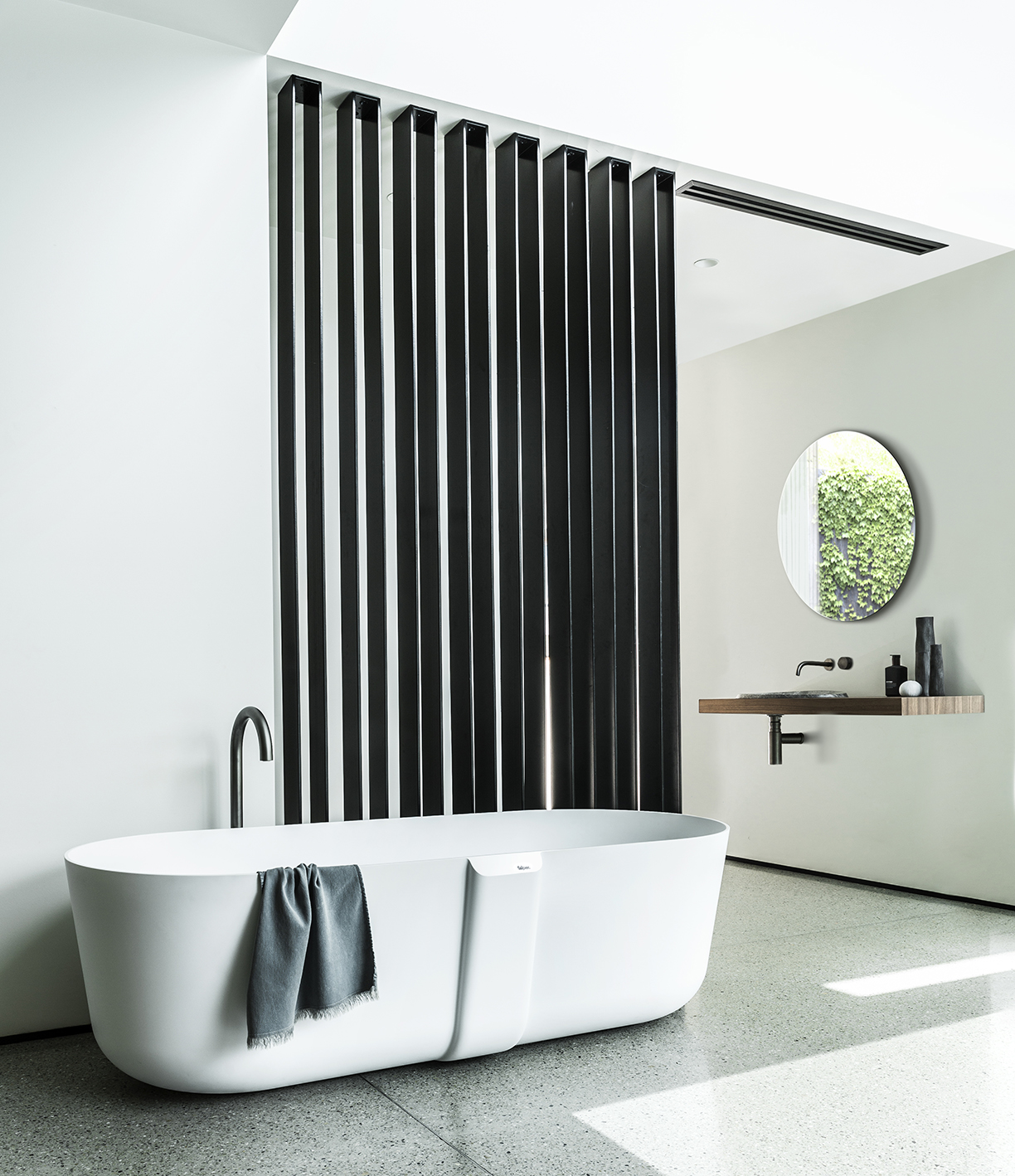

Fantini
At its core, Fantini is all about water. Since 2012, its “100 Fontane: Fantini for Africa” project has succeeded in bringing clean water to 25,000 people in Masango, Burundi, through the construction of 12 collection wells, 27km of aqueducts and 100 water outlets.
Fantini products also adhere to the most stringent standards to safeguard consumer health. Its products are certified Lead free (containing less than 0.25 percent) whilst they’re also utilizing more stainless steel across all of its collections. A compact and solid material, stainless steel offers the highest resistance to corrosion and is particularly hard-wearing and durable, facilitating maximum hygiene. In addition, it’s also an eco-friendly and recyclable material.
At left: Fantini Mare Basin Mixer
Running completely on electricity, the Mirage Air is elevating the standard of eco-friendly yachts.
For those with a heart for being eco-friendly, renowned yacht builder Frauscher Shipyard has launched a sleek, silent, electric version of its 740 Mirage Air powered by Torqeedo’s Deep Blue 100i.
Owners can cruise silently at 10 km/h for more than 10 hours, appreciating both the natural world and the yacht’s spacious, centre-console layout, distinctive design and extraordinary quality.
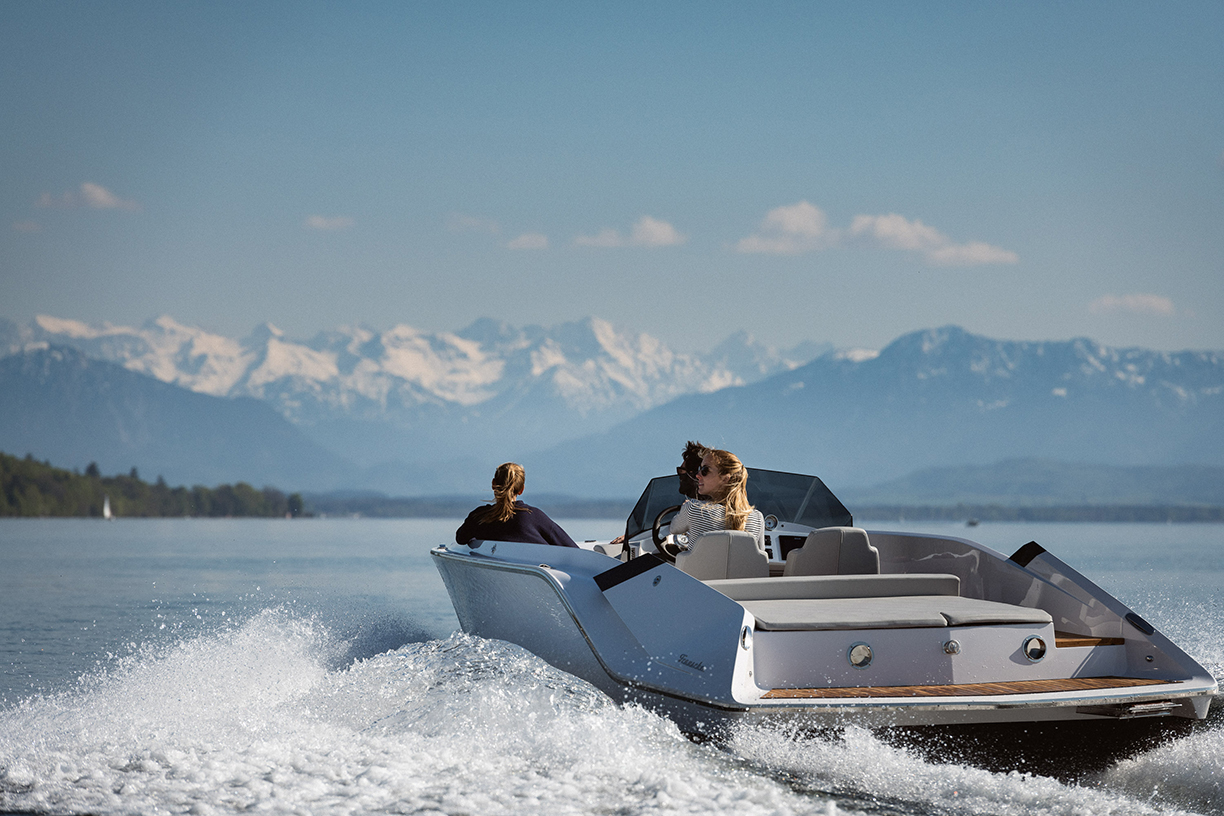
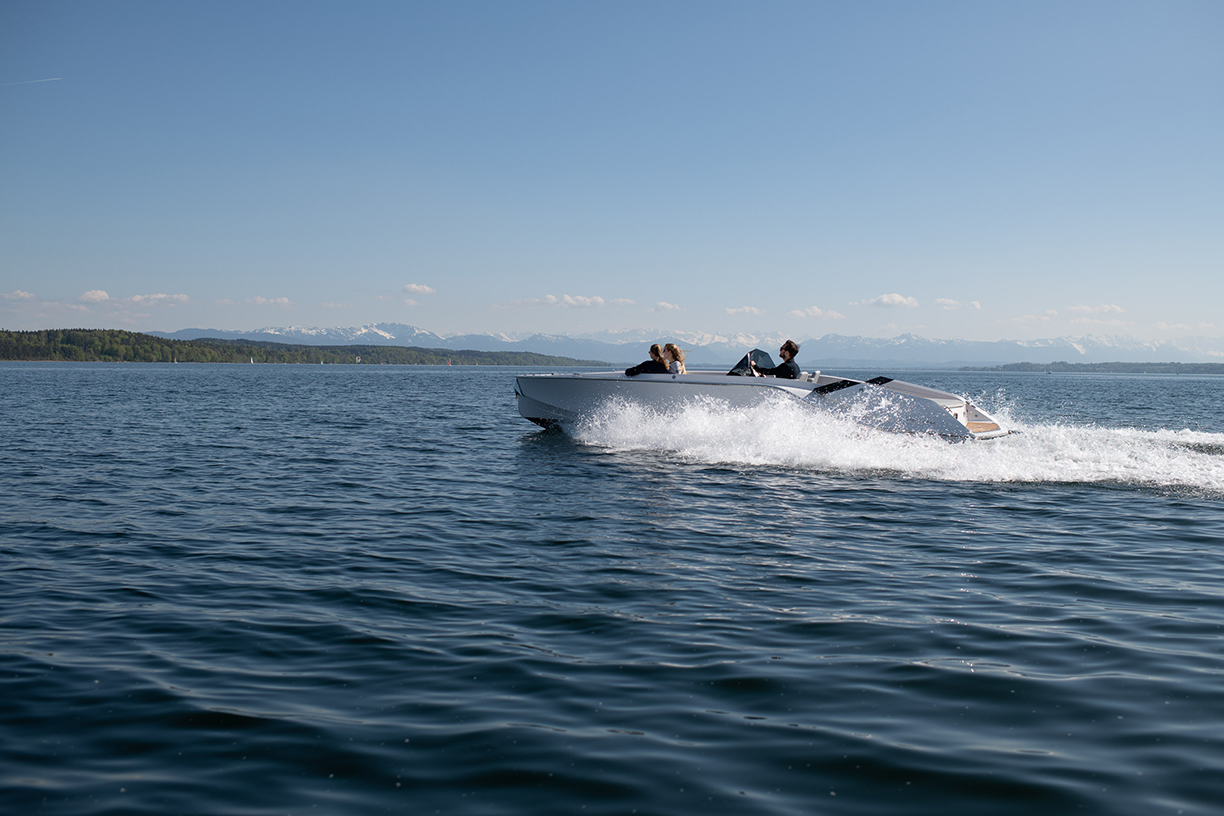

The fully electric 740 Mirage Air further enhances tradition with innovation, high-tech features and eco-friendliness. Installed with a Deep Blue 100 kW electric inboard motor and two lithium batteries with BMW technology (i3-type), the 740 Mirage Air is the ideal day cruiser.
“At Frauscher Shipyard, we see ourselves as ‘Engineers of Emotions,’ and we always want the owners of our boats to have a great time on the water. With the powerful 100 kW drive system, we are entering an entirely new dimension of electric mobility on the water,” says Frauscher Shipyard’s managing partner Stefan Frauscher.
The 7.47-meter yacht was designed by studio KISKA and Thomas Gerzer, alongside hydrodynamic expert Harry Miesbauer. Although the dynamic lines are suggestive of luxury car design, inside you’ll find all the comforts one could desire: a silent, environmentally friendly electric drive, refrigerated compartment, high-tech yet easy-to-use controls and displays, large sunbathing area, electric windlass, and a bow thruster for foolproof docking.
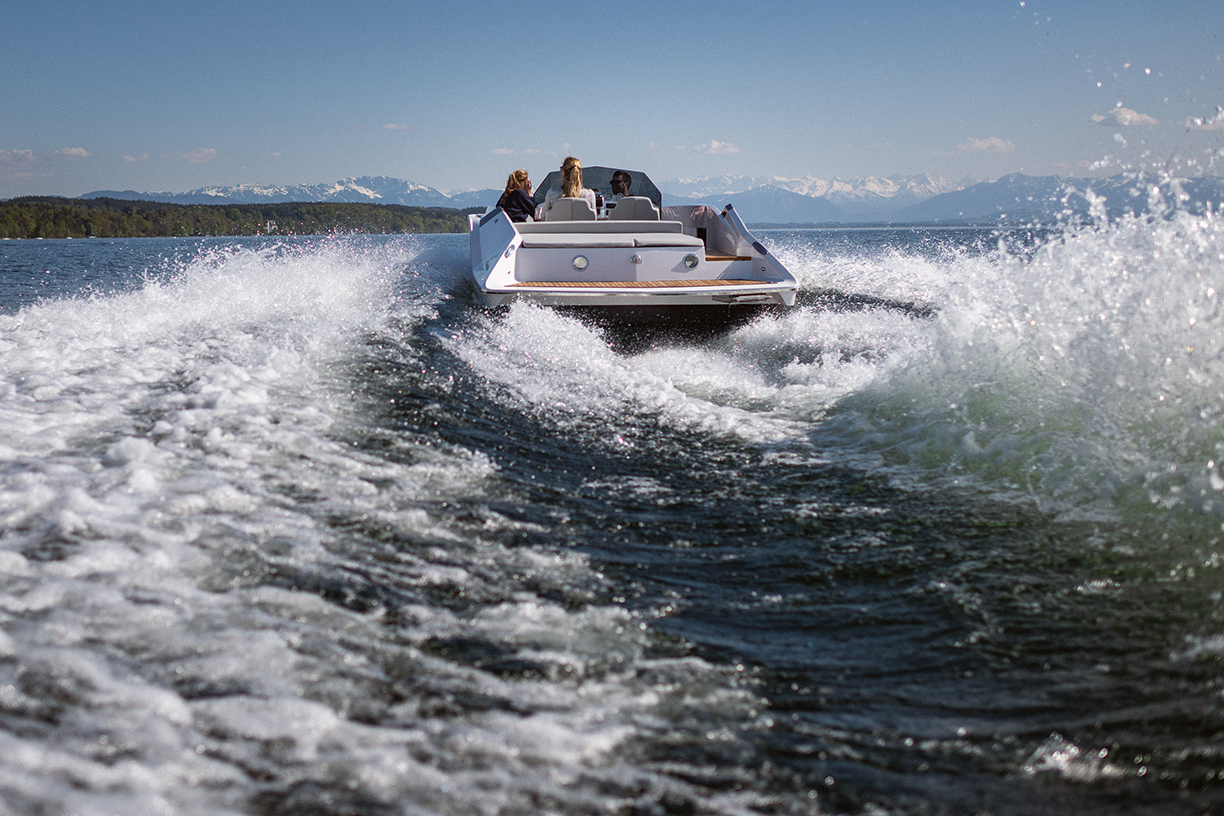
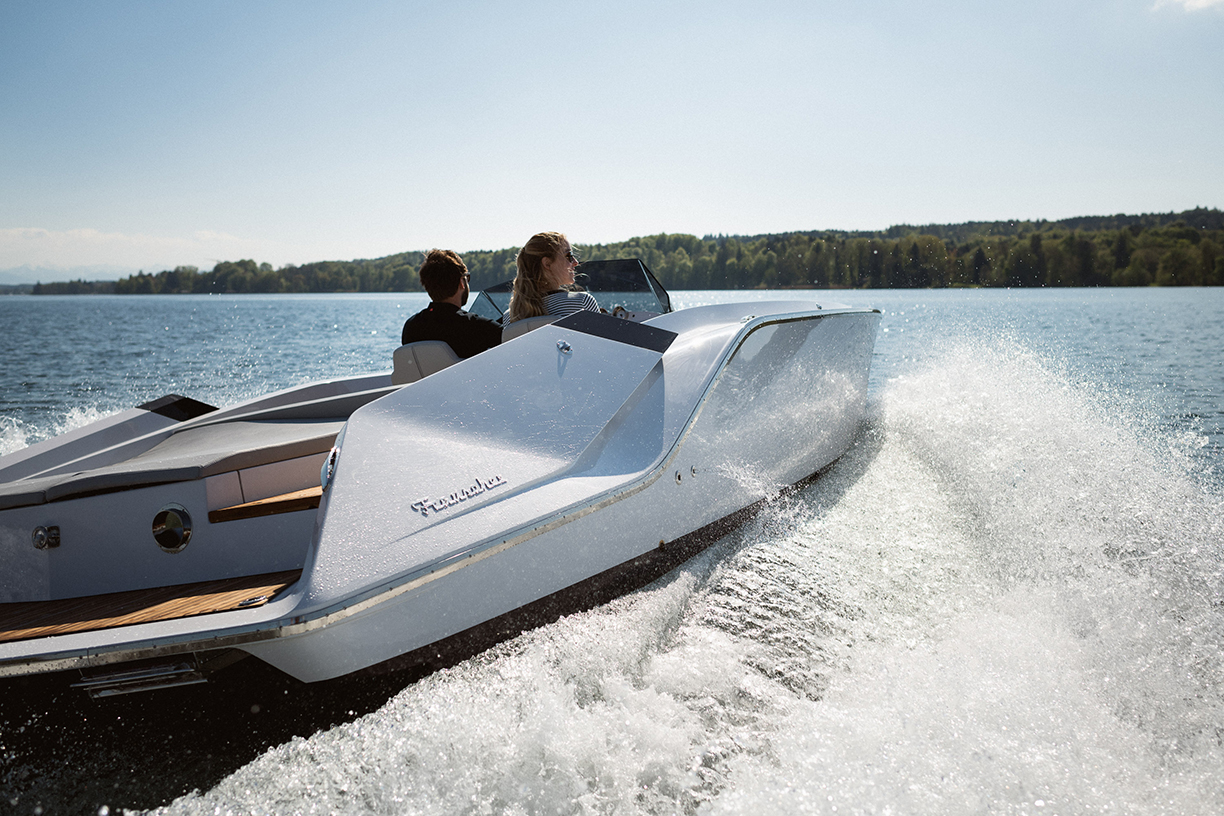
The whisper-quiet engine used in the Frauscher 740 Mirage Air is specifically designed and constructed to power planing motorboats. The system’s reliable and easy-to-maintain design delivers extraordinary performance at its full power range, with up to 2,400 rpm and incredible torque delivered at low rpm.
The 40 kWh Deep Blue batteries installed in the 740 Mirage Air bring the latest in automotive-grade lithium-ion technology from the famed motor works of BMW. The batteries feature industry-leading energy density and a comprehensive safety system. Torqeedo has tailored the characteristics of the Deep Blue battery to make it suitable for the marine environment and is offering up to a nine-year limited battery capacity warranty.
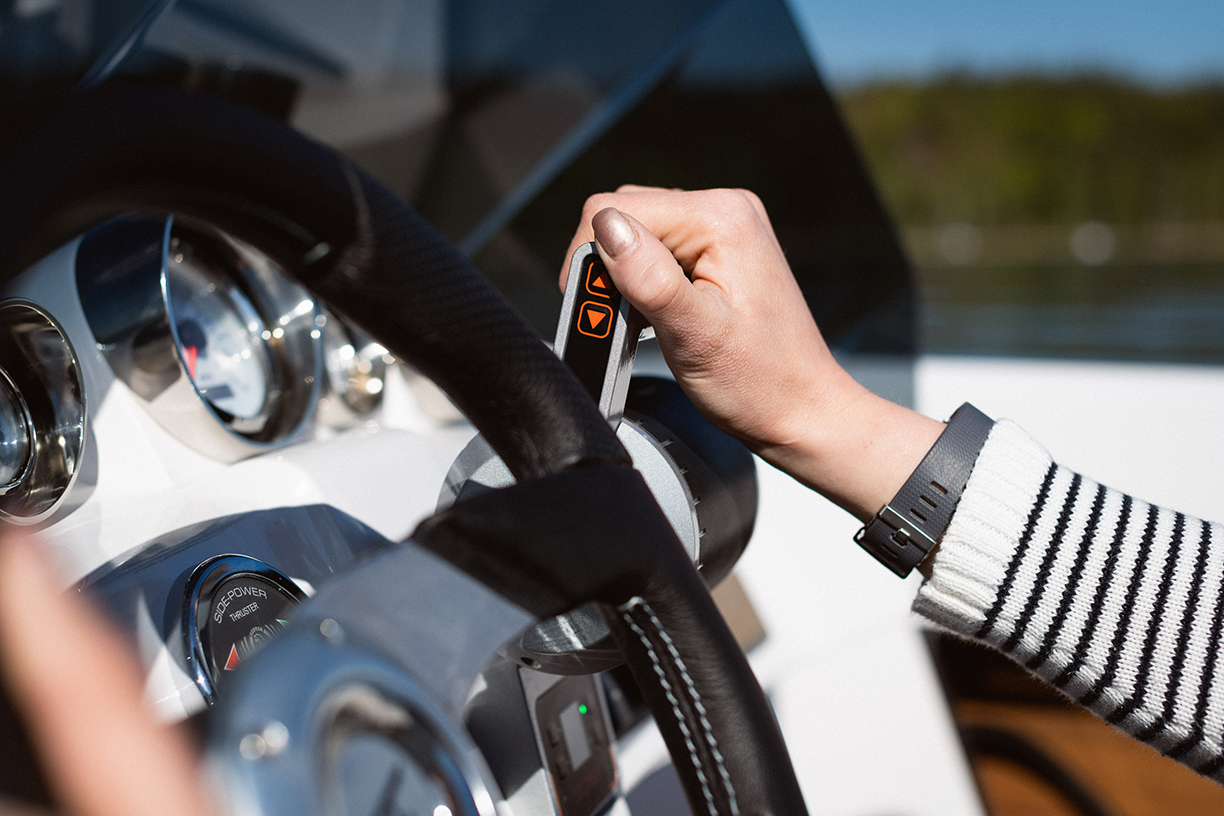

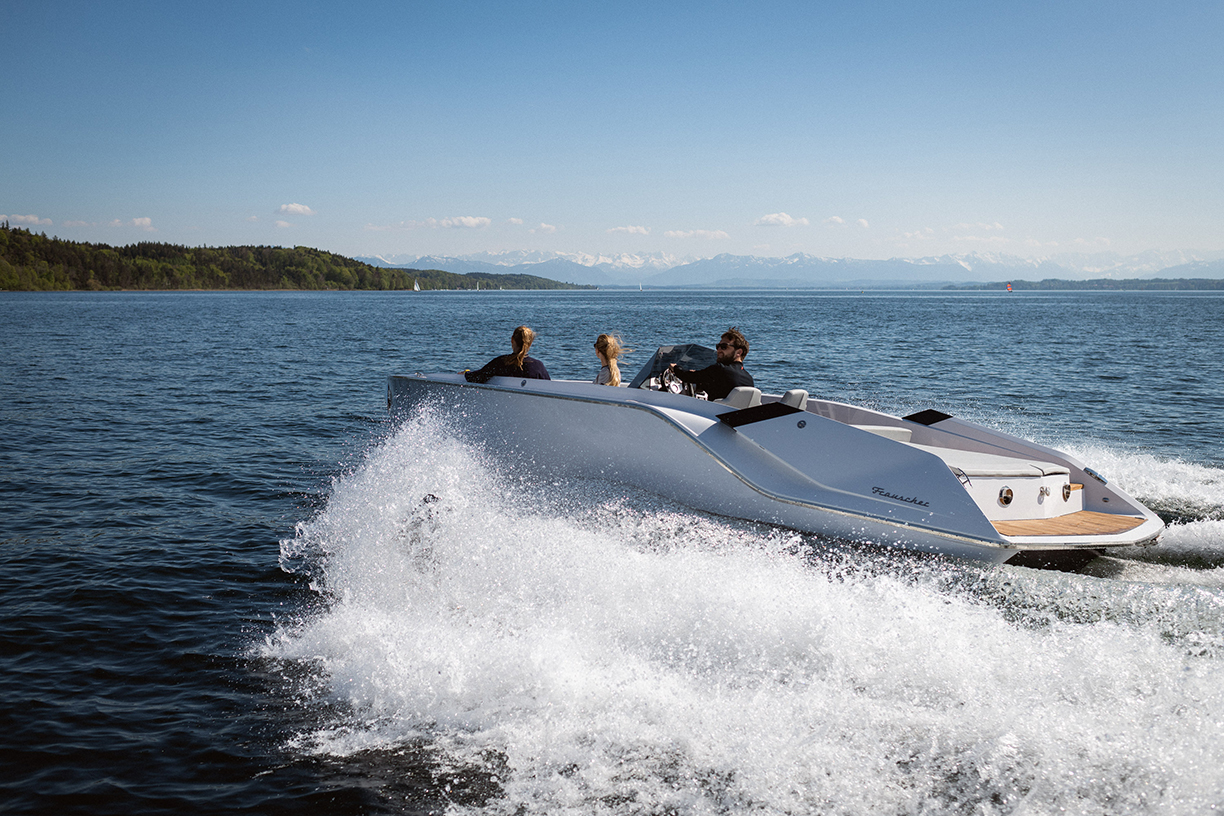
“The Frauscher 740 Mirage Air provides a quiet and powerful luxury yachting experience for boats that operate in sensitive areas and those with a heart for nature,” says Torqeedo CEO Christoph Ballin. “With an industrially engineered, fully integrated electric drive system and the extraordinary craftsmanship of the Frauscher Shipyard, this electric yacht will attract the eye of discerning owners worldwide.”
Photos courtesy of Christian Brecheis
Eco-friendly furniture and sustainable decor are more than a cute trend — they are a priority for STEM.
With the increasing amount of plastic in our oceans, shrinking forests, and our overall impact on Mother Earth, sustainable designs are becoming more and more popular. Companies like STEM are realizing the importance of sourcing materials responsibly and spreading the message.
Going beyond the typical one or two eco-friendly pieces that most companies offer, STEM’s collection takes sustainability carefully into consideration. Founded by two brothers, Ryan and Travis, STEM is inspiring buyers and designers alike with its entirely eco-friendly collection. The company prides itself on creating a “Healthy Planet, Healthy Home.”
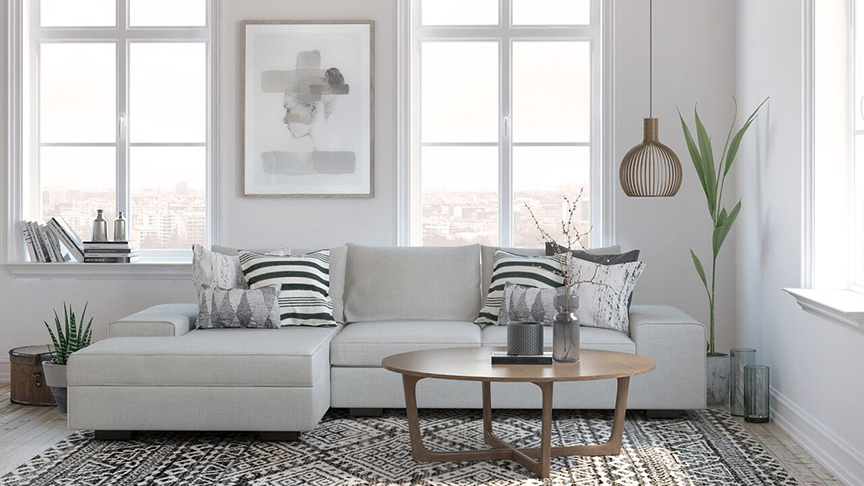
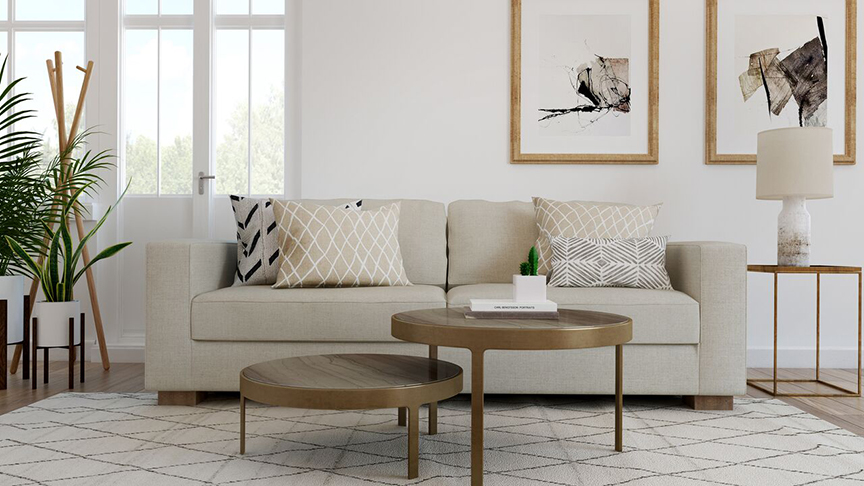
STEM ensures satisfaction by building each piece one at a time in L.A. from eco-materials like natural latex and wool, bamboo, organic cotton, and more. Cutting out harsh chemicals like fire retardants and certain glues are also a part of the process. Sofas and sectionals — being the biggest portion of STEM’s business — are made with FSC certified wood frames, natural jute, and organic cotton. Pieces like the Rio Sofa and Blumen Sectional can be made to the inch to get it just right for each customer and space.
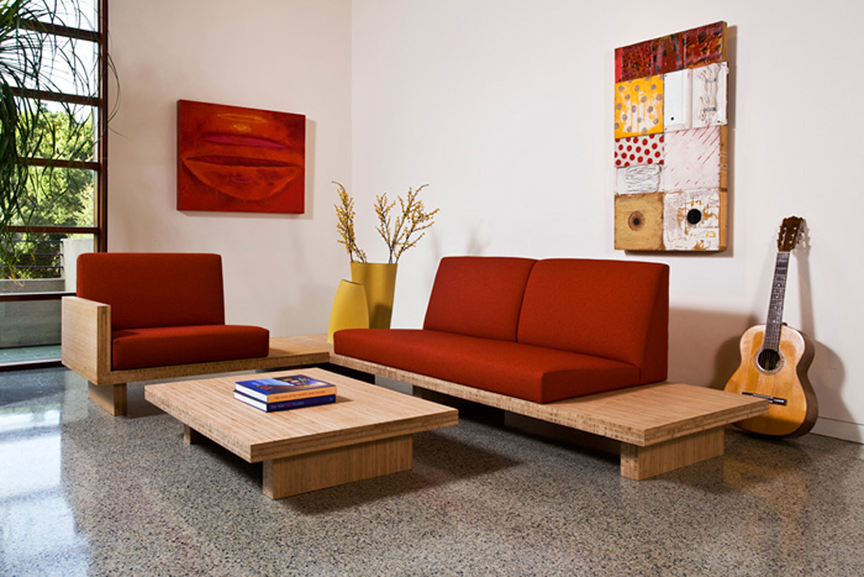
Bamboo Float is a unique style that STEM incorporates into sofas, tables, and more. Bamboo is an ideal material because it grows as quickly as a weed. STEM uses sheets of bamboo for the base and then attaches an upholstered piece for the seating component.
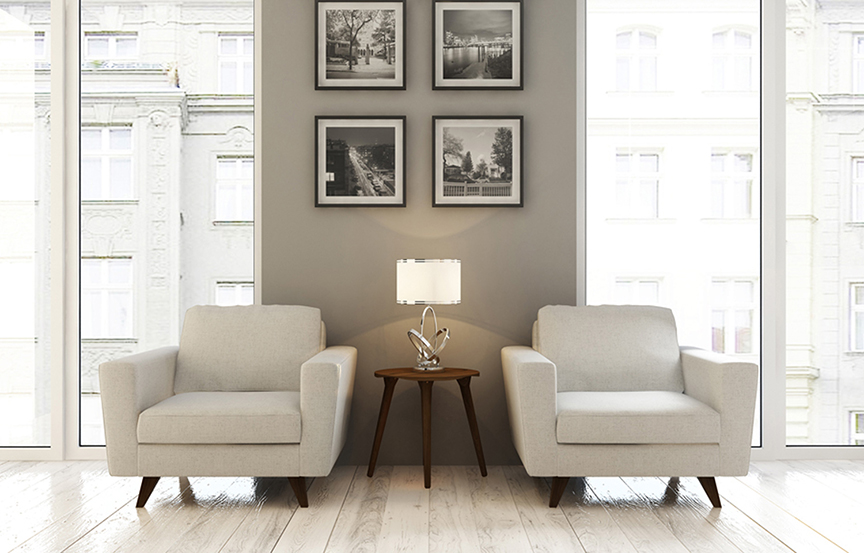
For the Voya Side Table, the piece is handcrafted with FSC certified walnut or hard maple and is covered in zero VOC matte finish. The design can also be made into a coffee table as well.
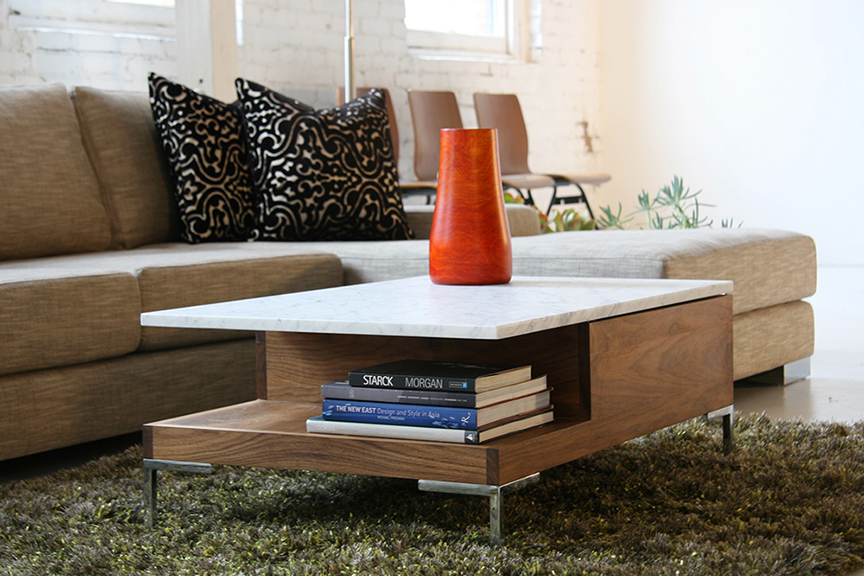
Also using FSC certified walnut or hard maple for the base is the Sino Coffee Table. The top is white carrera marble and has the option for a draw for storage. STEM makes each piece as it’s needed, therefore cutting out the mass production of generic goods.
Working to develop urban areas around the country is based on focusing on and improving the lives of residents for future years to come. To emphasize these goals, many developments are implementing sustainability methods in design and architecture to benefit the surrounding community and inhabitants.
Urby — Staten Island, NY
Located on the North Shore waterfront, Staten Island Urby is the largest new-construction development in Staten Island that offers specially curated social spaces that encourage natural opportunities for neighbors to meet and interact, including an urban farm featuring farmer-in-residence, Zaro Bates.
The 5,000-square-foot farm is the first commercial farm to be incorporated into an urban residential development. The farm grows over 50 varieties of produce across 5 major categories: greens, summer vegetables, flowers, herbs and roots. The farmers offer workshops to the community and residents including a fermentation series, growing your own herbs and microgreens, and bee-keeping workshops. Produce from the farm is used by the residents, served in the kitchen and sold at a weekly farmer’s market. Zaro’s business partner, Asher Landes, oversees the apiary, which encompasses 20 beehives on the roof of Urby that produce honey.
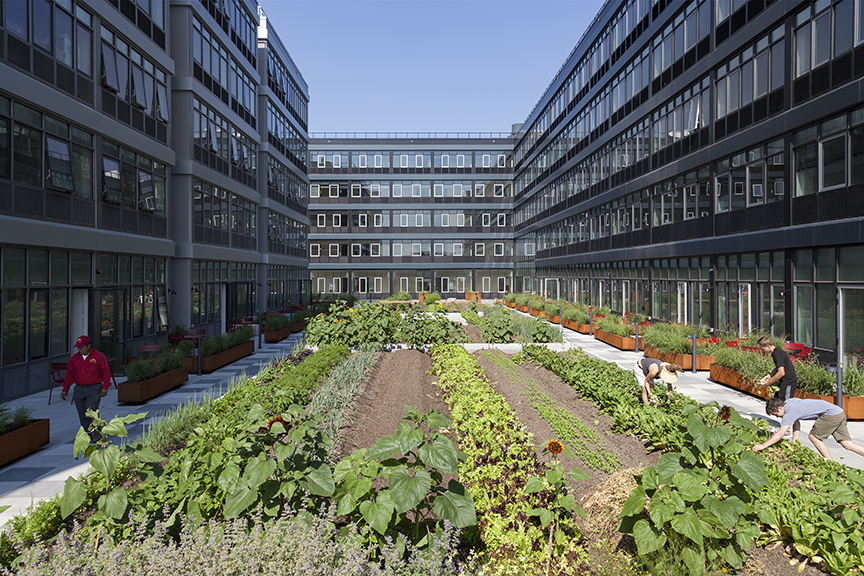
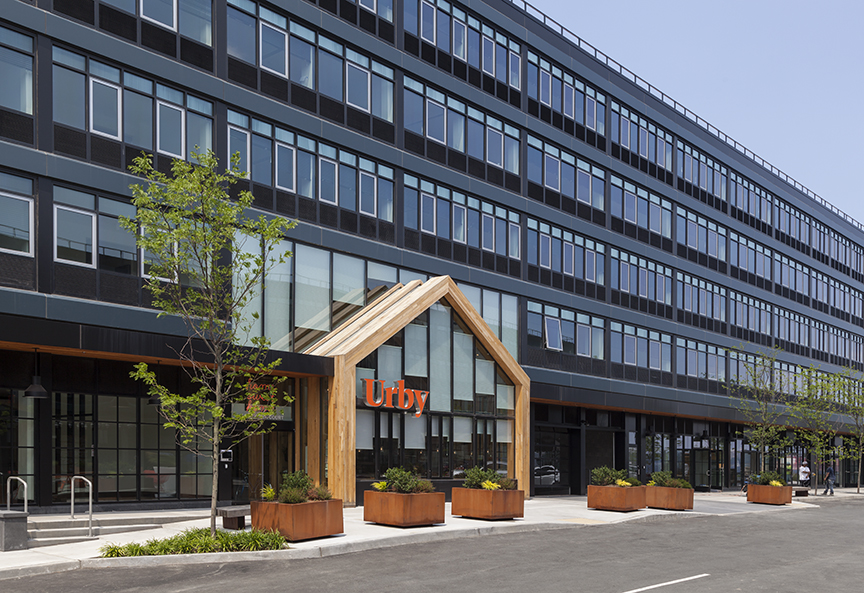
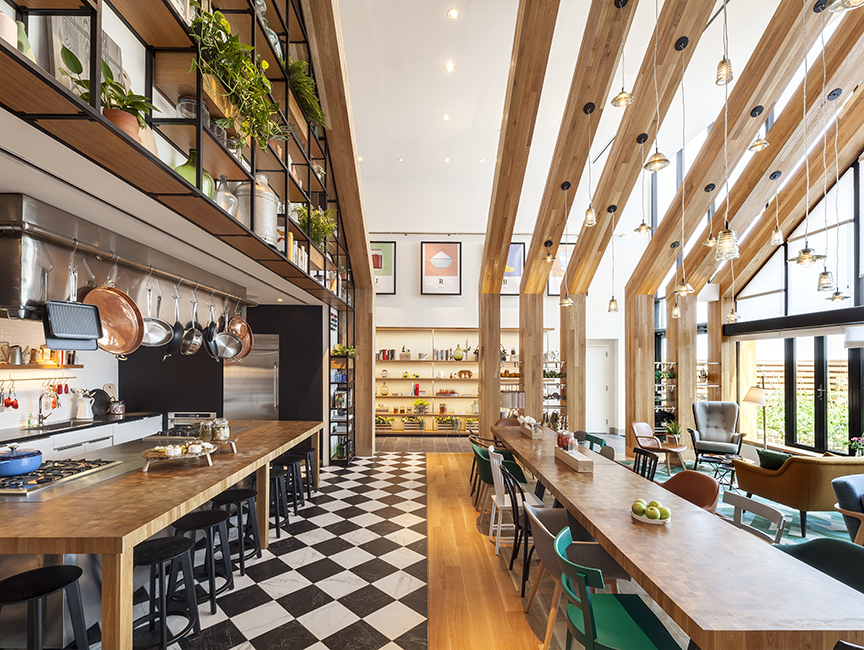
Photos courtesy of Ewout Huibers
Residence 2680 – San Francisco, CA
Located in the prestigious Pacific Heights neighborhood, Residence 2680 is the largest single-family home renovation that is built to Passive House standards with Home Platinum LEED certification in San Francisco. Developed by Troon Pacific and built to strict sustainability standards, naturally sourced, low-chemical producing materials like wood, stone and glass were incorporated throughout the home.
“We believe in the inspirational power of natural beauty and use principles of biophilic design throughout our homes to uplift our spirits and enhance health and wellness in the urban environment,” says Gregory Malin, CEO of Troon Pacific. Gregory Malin.
With mental and physical wellness in mind, Troon Pacific incorporates a variety of design features, such as Zen wellness gardens, retractable skylights to provide natural ventilation and clean air, rain chains for natural water filtration, landscaped roof decks, saunas, steam rooms and more.
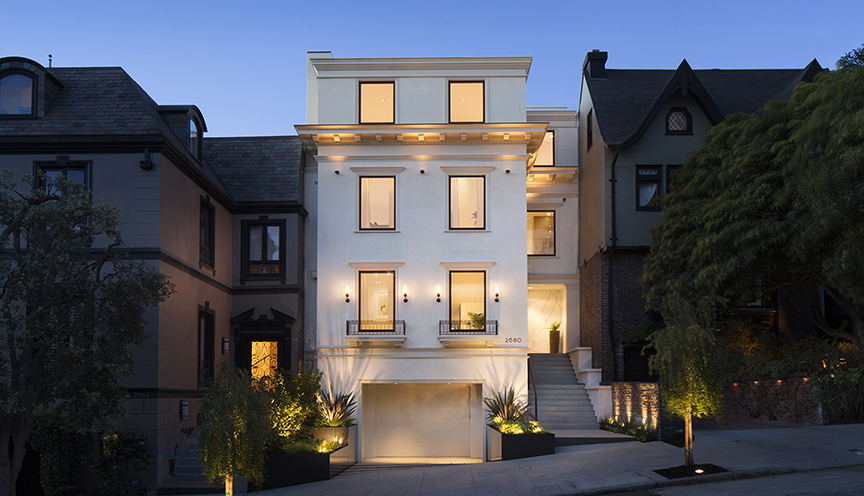
Photo courtesy Troon Pacific.
570 Broome — SoHo, NY
570 Broome is a new 54-unit luxury boutique condominium that is the latest addition to Hudson Square, which has become a highly sought-after residential neighborhood and go-to destination for retailers, restaurants and businesses.
The material used to build the condominium is a result of a new collaboration between sintered stone slabs and Pureti, an aqueous and titanium dioxide nanoparticle-based treatment. This treatment on the surface of the building is activated through light energy to transform the moisture in the air into oxidizing agents, which destroy pollution-causing particles. For 570 Broome, this equates to taking 2,000 cars off the road for a year or the purifying power of 500 trees.
The overall architectural design references the area’s history through the large framed windows, along with the building’s silhouette evocative of staggered cubes.
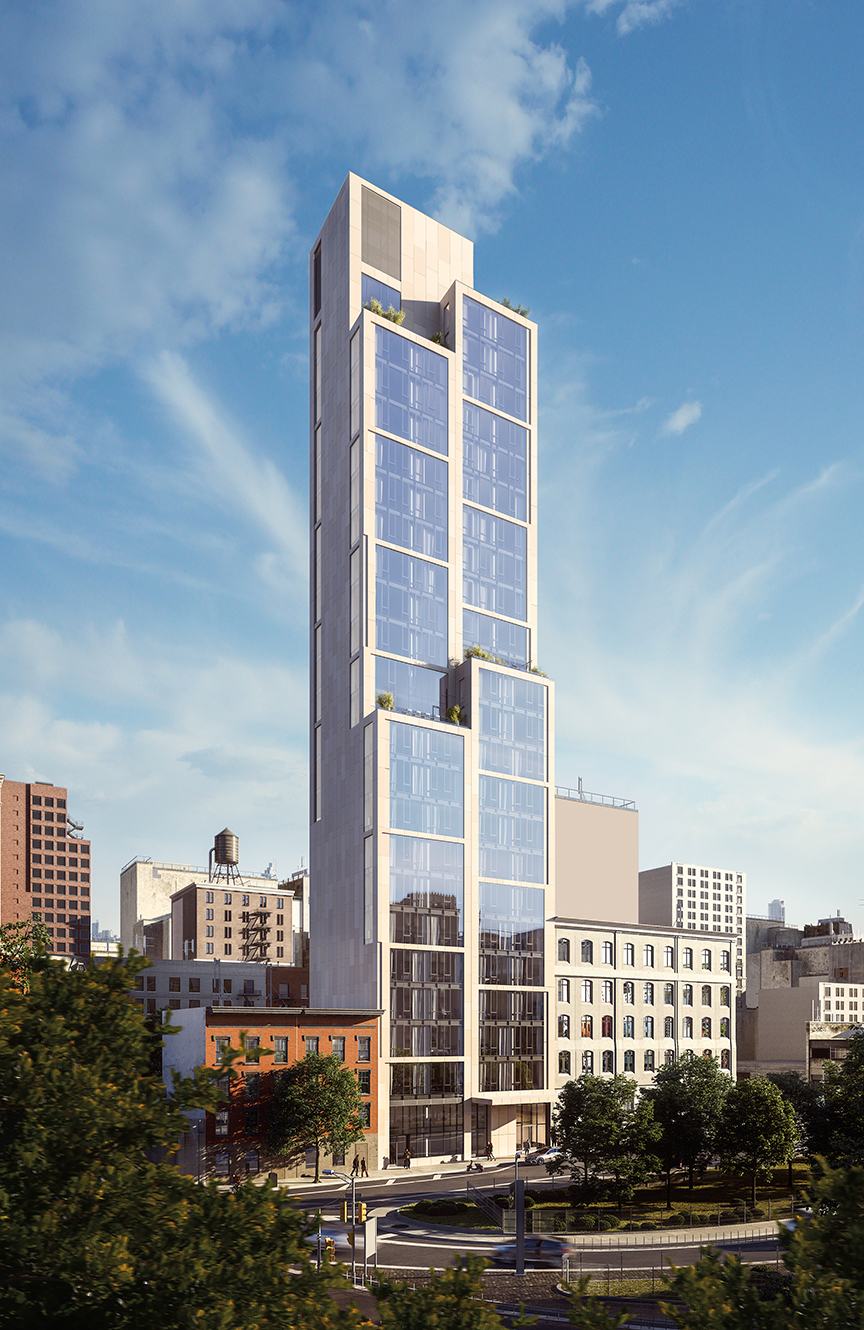

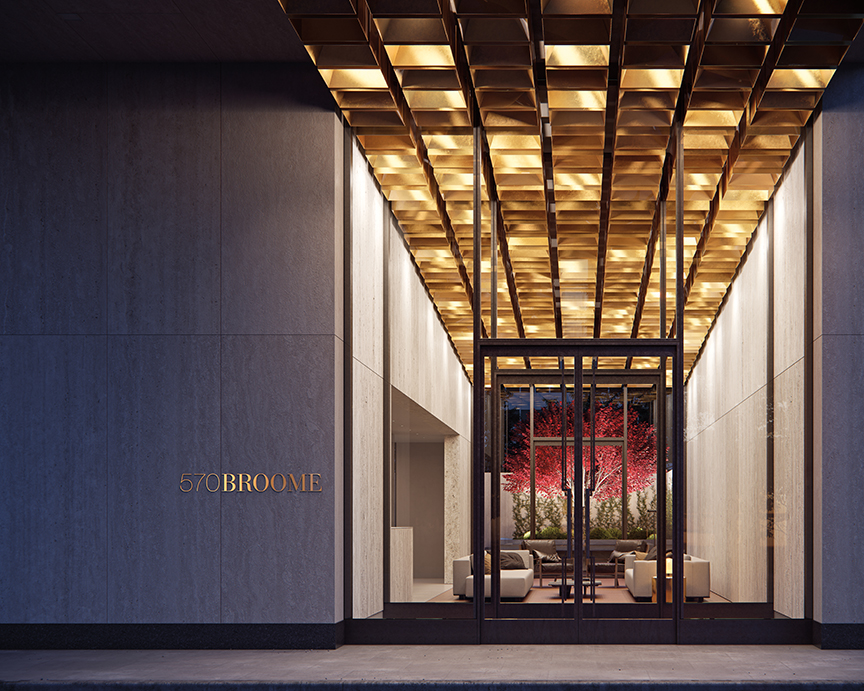
Photos courtesy Builtd.
Manitoba Hydro Place — Winnipeg, Canada
Manitoba Hydro Place offers a fully integrated design that capitalizes on Winnipeg’s abundance of sunshine and gusting winds to harness solar and wind energies. The capital “A” form of the tower comprises two wings fused at the north and splayed open to the south. This opening is filled with three, six-story stacked atria or winter gardens that act as the lungs of the building as well as 78-foot waterfalls that humidify/dehumidify incoming air.
The design is 80-percent more efficient than conventional Winnipeg buildings, making it the third most energy-efficient, large scale building in the world. It is also the first large-scale office tower in North America to be LEED Platinum-certified.
Photo courtesy Gerry Kopelow.
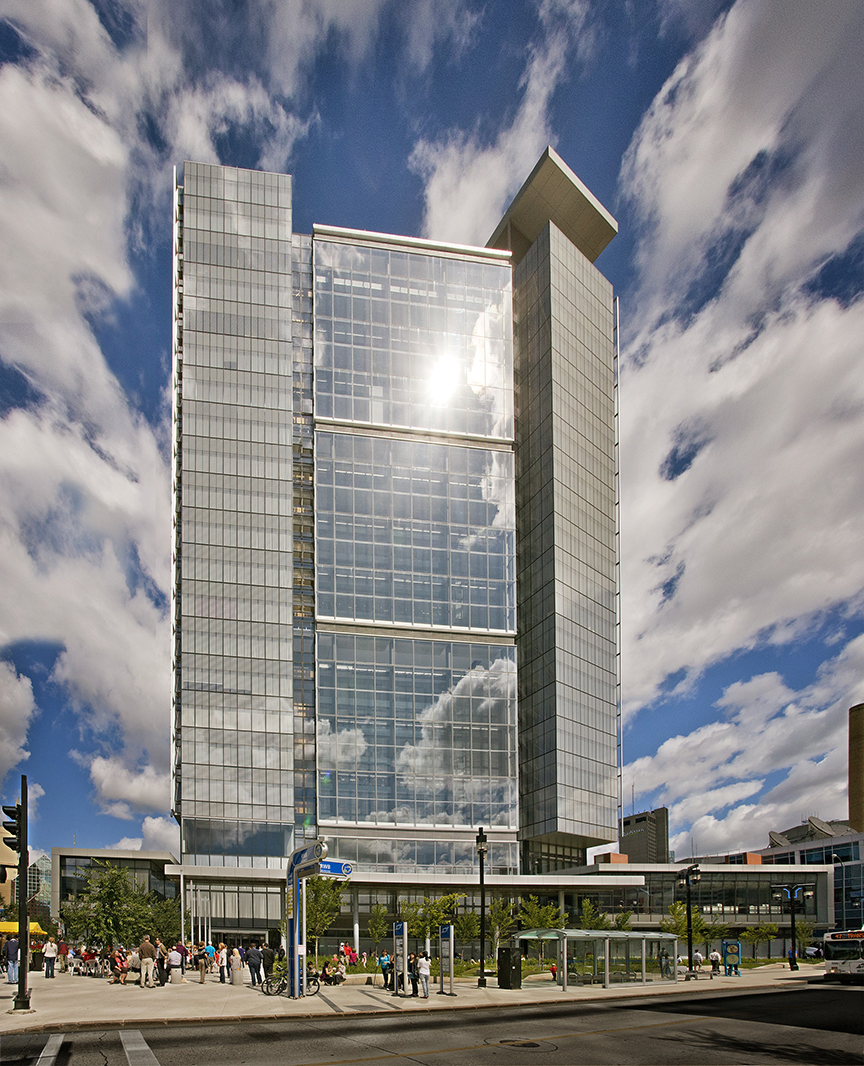
Market Square — San Francisco, CA
Market Square, a Gold LEED-certified project, was designed by BCV Architecture + Interiors with sustainability and community in mind. The two-building project transformed the dark, outdated and unused space into a cohesive part of its Mid-Market San Francisco neighborhood.
Natural and recycled materials, including reclaimed wood from one of the building’s earlier additions, are used throughout. Market Square merges state-of-the-art office space with an integrated ground floor community featuring the best of San Francisco’s food and retail purveyors. BCV Architecture + Interiors view sustainability through a myriad of lenses and considers the ethical, cultural, social, economic and historical implication of a project in addition to the technical solutions.
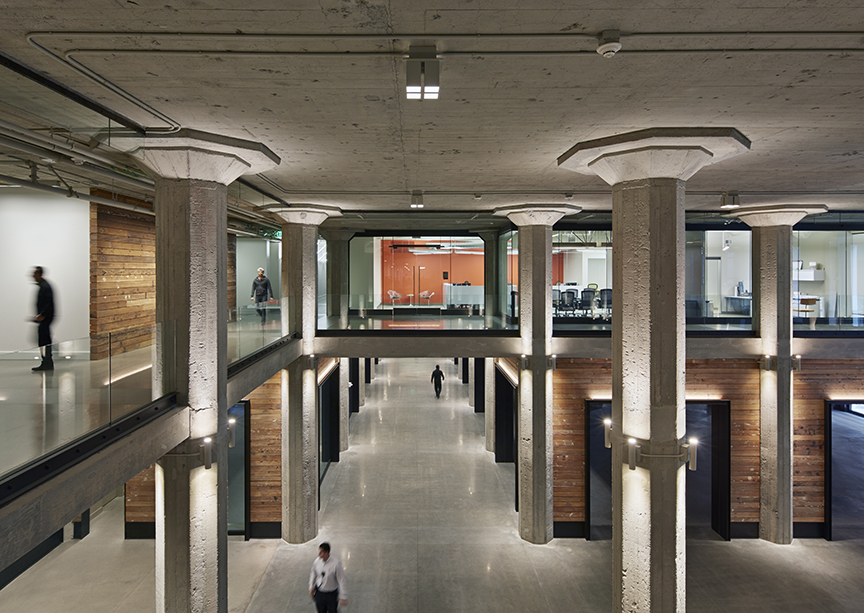
Photo courtesy Bruce Damonte.
12 Warren — Tribeca, NY
12 Warren is a boutique residential condominium nestled in Tribeca developed, designed and constructed by DDG. This development features a hand-laid façade and is an impressive addition to one of Manhattan’s most desired residential neighborhoods.
12 Warren is specifically designed with NYC Energy Code compliance and LEED certification in mind, targeting a Silver level LEED certification. Additional components include a green roof system, accommodating alternative transportation storage, stormwater collection and reuse, reduction of heat island effect with concrete, light grey toned pavers and landscaping elements, construction waste management and secondary tenant-controlled heating elements to reduce overall energy and electrical output. By choosing native and local materials, such as Bluestone from upstate New York, something close to home and natural, helped ensure more sustainable building practices.
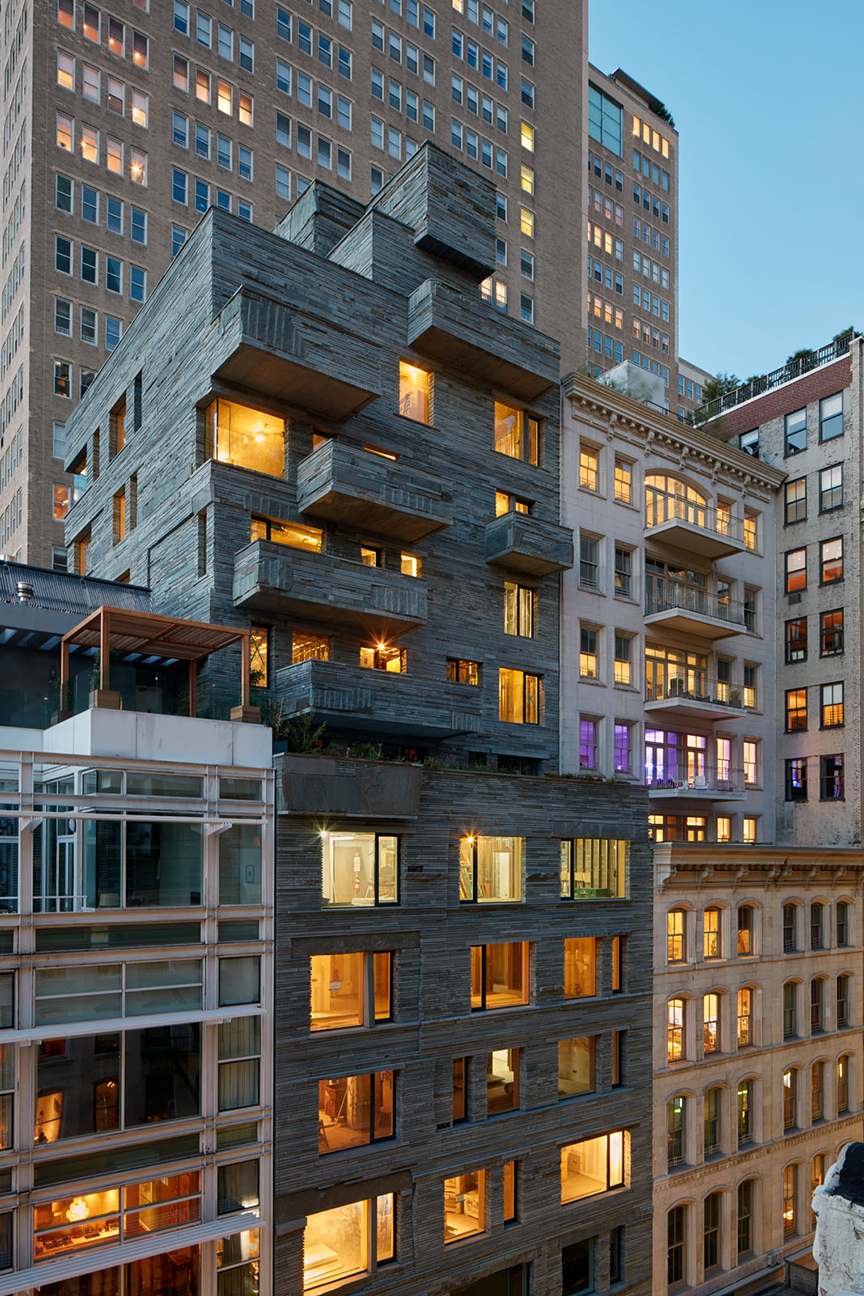
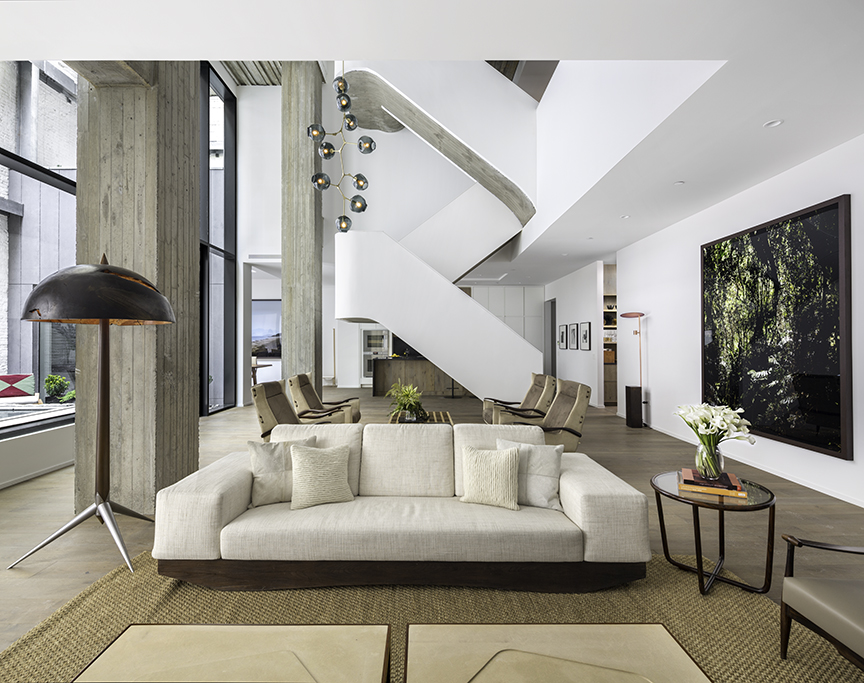
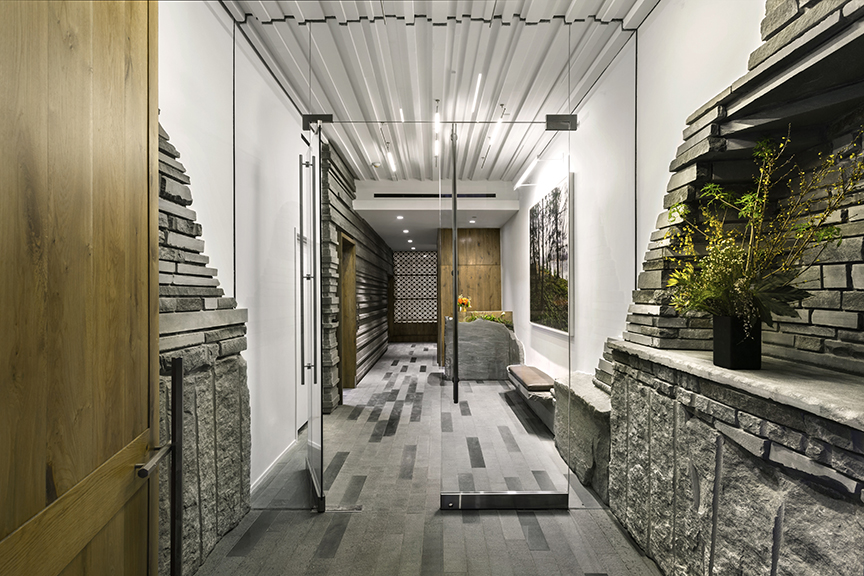
Top left photo courtesy of Bruce Damonte. Top and bottom right photo courtesy Robert Granoff.


